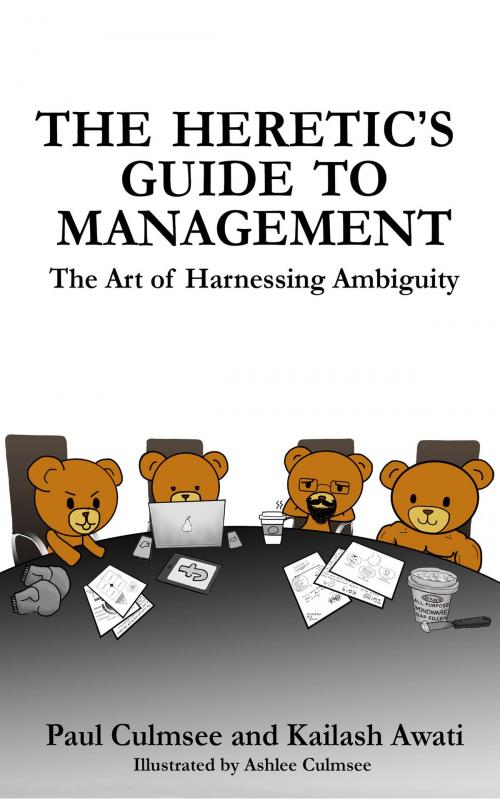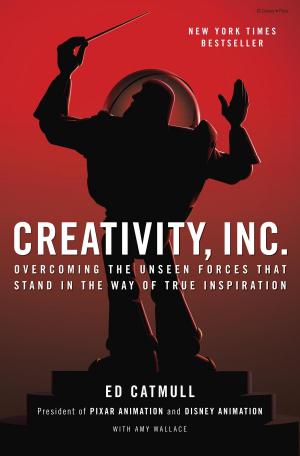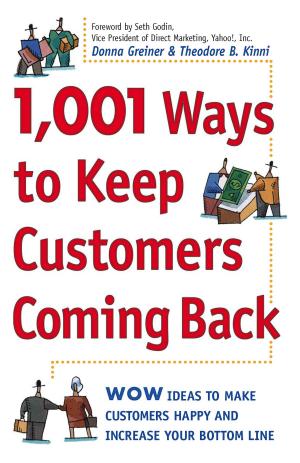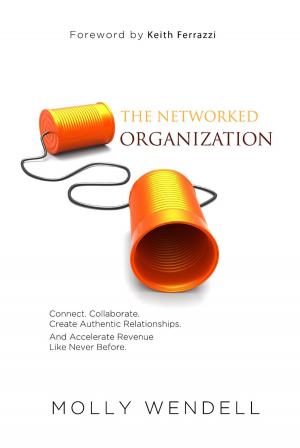The Heretic's Guide To Management
The Art of Harnessing Ambiguity
Business & Finance, Management & Leadership, Decision Making & Problem Solving, Leadership, Management| Author: | Paul Culmsee, Kailash Awati | ISBN: | 9780994631404 |
| Publisher: | Heretics Guide Press | Publication: | July 7, 2016 |
| Imprint: | Heretics Guide Press | Language: | English |
| Author: | Paul Culmsee, Kailash Awati |
| ISBN: | 9780994631404 |
| Publisher: | Heretics Guide Press |
| Publication: | July 7, 2016 |
| Imprint: | Heretics Guide Press |
| Language: | English |
Management techniques such as strategic planning, project management or operational budgeting, aim to reduce ambiguity and provide clarity. So it is one of the great ironies of modern corporate life that these techniques often end up doing the opposite: increasing ambiguity rather than reducing it.
It is easy enough to understand why: organizations are complex entities and it is unreasonable to expect management models, such as those that fit neatly into a 2*2 matrix or a predetermined checklist, to work in the real world. Indeed, expecting them to work as advertised is akin to colouring a paint-by-numbers Mona Lisa with the expectation of recreating Da Vinci's masterpiece. Ambiguity has not been tamed: reality will still impose itself no matter how alluring the model is.
Unfortunately, most of us have a deep aversion to situations that involve even a hint of ambiguity. Recent research in neuroscience has revealed the reason for this: ambiguity is processed in the parts of the brain which regulate our emotional responses. As a result, many people associate ambiguity with feelings of anxiety.
When kids feel anxious, they turn to transitional objects such as teddy bears or security blankets, providing them with a sense of stability when situations or events seem overwhelming. We contend that as grown-ups, we don't actually stop using teddy bears - they take a different form. Backed by research, we illustrate that management models, fads and frameworks are akin to teddy bears . They provide the same sense of comfort and certainty to corporate managers and minions as real teddies do to distressed kids.
This is not a problem in many cases. Children usually outgrow their need for a teddy, unless if development is disrupted or arrested in some way. If this happens, the transitional object can become a fetish - an object that is held on to with a pathological intensity, simply for the comfort that it offers in the face of ambiguity. The corporate reliance on simplistic solutions for the complex challenges faced is akin to little Johnny believing that everything will be OK provided he clings on to Teddy.
Ambiguity is a primal force that drives much of our behaviour. It is typically viewed negatively - something to be avoided or to be controlled. The truth however, is that it is a force that can be used in positive ways too. The Force that gave the Dark Side their power in the Star Wars movies was harnessed by the Jedi in positive ways. Similarly, this new management book shows how ambiguous situations, so common in the corporate world, are processed by the brain, and the behaviours that often arise as a consequence. More importantly, though, it shows you how to harness that ambiguity to achieve outstanding results.
It is easy enough to understand why: organizations are complex entities and it is unreasonable to expect management models, such as those that fit neatly into a 2*2 matrix or a predetermined checklist, to work in the real world. Indeed, expecting them to work as advertised is akin to colouring a paint-by-numbers Mona Lisa with the expectation of recreating Da Vinci's masterpiece. Ambiguity has not been tamed: reality will still impose itself no matter how alluring the model is.
Unfortunately, most of us have a deep aversion to situations that involve even a hint of ambiguity. Recent research in neuroscience has revealed the reason for this: ambiguity is processed in the parts of the brain which regulate our emotional responses. As a result, many people associate ambiguity with feelings of anxiety.
When kids feel anxious, they turn to transitional objects such as teddy bears or security blankets, providing them with a sense of stability when situations or events seem overwhelming. We contend that as grown-ups, we don't actually stop using teddy bears - they take a different form. Backed by research, we illustrate that management models, fads and frameworks are akin to teddy bears . They provide the same sense of comfort and certainty to corporate managers and minions as real teddies do to distressed kids.
This is not a problem in many cases. Children usually outgrow their need for a teddy, unless if development is disrupted or arrested in some way. If this happens, the transitional object can become a fetish - an object that is held on to with a pathological intensity, simply for the comfort that it offers in the face of ambiguity. The corporate reliance on simplistic solutions for the complex challenges faced is akin to little Johnny believing that everything will be OK provided he clings on to Teddy.
Ambiguity is a primal force that drives much of our behaviour. It is typically viewed negatively - something to be avoided or to be controlled. The truth however, is that it is a force that can be used in positive ways too. The Force that gave the Dark Side their power in the Star Wars movies was harnessed by the Jedi in positive ways. Similarly, this new management book shows how ambiguous situations, so common in the corporate world, are processed by the brain, and the behaviours that often arise as a consequence. More importantly, though, it shows you how to harness that ambiguity to achieve outstanding results.
Management techniques such as strategic planning, project management or operational budgeting, aim to reduce ambiguity and provide clarity. So it is one of the great ironies of modern corporate life that these techniques often end up doing the opposite: increasing ambiguity rather than reducing it.
It is easy enough to understand why: organizations are complex entities and it is unreasonable to expect management models, such as those that fit neatly into a 2*2 matrix or a predetermined checklist, to work in the real world. Indeed, expecting them to work as advertised is akin to colouring a paint-by-numbers Mona Lisa with the expectation of recreating Da Vinci's masterpiece. Ambiguity has not been tamed: reality will still impose itself no matter how alluring the model is.
Unfortunately, most of us have a deep aversion to situations that involve even a hint of ambiguity. Recent research in neuroscience has revealed the reason for this: ambiguity is processed in the parts of the brain which regulate our emotional responses. As a result, many people associate ambiguity with feelings of anxiety.
When kids feel anxious, they turn to transitional objects such as teddy bears or security blankets, providing them with a sense of stability when situations or events seem overwhelming. We contend that as grown-ups, we don't actually stop using teddy bears - they take a different form. Backed by research, we illustrate that management models, fads and frameworks are akin to teddy bears . They provide the same sense of comfort and certainty to corporate managers and minions as real teddies do to distressed kids.
This is not a problem in many cases. Children usually outgrow their need for a teddy, unless if development is disrupted or arrested in some way. If this happens, the transitional object can become a fetish - an object that is held on to with a pathological intensity, simply for the comfort that it offers in the face of ambiguity. The corporate reliance on simplistic solutions for the complex challenges faced is akin to little Johnny believing that everything will be OK provided he clings on to Teddy.
Ambiguity is a primal force that drives much of our behaviour. It is typically viewed negatively - something to be avoided or to be controlled. The truth however, is that it is a force that can be used in positive ways too. The Force that gave the Dark Side their power in the Star Wars movies was harnessed by the Jedi in positive ways. Similarly, this new management book shows how ambiguous situations, so common in the corporate world, are processed by the brain, and the behaviours that often arise as a consequence. More importantly, though, it shows you how to harness that ambiguity to achieve outstanding results.
It is easy enough to understand why: organizations are complex entities and it is unreasonable to expect management models, such as those that fit neatly into a 2*2 matrix or a predetermined checklist, to work in the real world. Indeed, expecting them to work as advertised is akin to colouring a paint-by-numbers Mona Lisa with the expectation of recreating Da Vinci's masterpiece. Ambiguity has not been tamed: reality will still impose itself no matter how alluring the model is.
Unfortunately, most of us have a deep aversion to situations that involve even a hint of ambiguity. Recent research in neuroscience has revealed the reason for this: ambiguity is processed in the parts of the brain which regulate our emotional responses. As a result, many people associate ambiguity with feelings of anxiety.
When kids feel anxious, they turn to transitional objects such as teddy bears or security blankets, providing them with a sense of stability when situations or events seem overwhelming. We contend that as grown-ups, we don't actually stop using teddy bears - they take a different form. Backed by research, we illustrate that management models, fads and frameworks are akin to teddy bears . They provide the same sense of comfort and certainty to corporate managers and minions as real teddies do to distressed kids.
This is not a problem in many cases. Children usually outgrow their need for a teddy, unless if development is disrupted or arrested in some way. If this happens, the transitional object can become a fetish - an object that is held on to with a pathological intensity, simply for the comfort that it offers in the face of ambiguity. The corporate reliance on simplistic solutions for the complex challenges faced is akin to little Johnny believing that everything will be OK provided he clings on to Teddy.
Ambiguity is a primal force that drives much of our behaviour. It is typically viewed negatively - something to be avoided or to be controlled. The truth however, is that it is a force that can be used in positive ways too. The Force that gave the Dark Side their power in the Star Wars movies was harnessed by the Jedi in positive ways. Similarly, this new management book shows how ambiguous situations, so common in the corporate world, are processed by the brain, and the behaviours that often arise as a consequence. More importantly, though, it shows you how to harness that ambiguity to achieve outstanding results.















